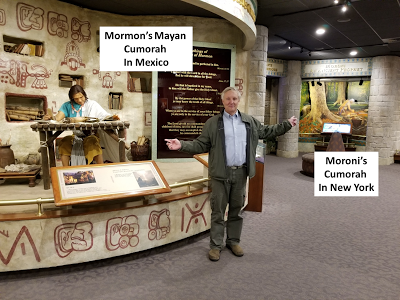Tuesday I visited Temple Square to admire the exhibit of two-Cumorahs that repudiates what Joseph Smith and Oliver Cowdery taught in Letter VII.
This exhibit also repudiates what every prophet and apostle has taught about Cumorah, including members of the First Presidency speaking in General Conference.
Most LDS people prefer to follow the prophets instead of the intellectuals, so how have the intellectuals prevailed in pushing their theory?
Because of visual persuasion–and presuasion.
_____
The saying goes, “a picture is worth a thousand words.” But for the Book of Mormon, a picture is worth 269,510 words (the number of words in the text).
Millions of visitors to Temple Square see this exhibit. Millions more see the ubiquitous painting of Christ visiting the Mayans, which is featured in the missionary edition of the Book of Mormon, in chapels and media worldwide–and even on the Temple Square Instagram page.
 |
| Temple Square instagram page |
Far more people (members, investigators, and the general public) see these images than will ever read the words in the Book of Mormon. But if people get around to actually reading the text, they will interpret it in a Mayan setting because of visual persuasion and visual presuasion.
 |
| Christ visiting earthworks, not Mayan stone pyramids |
Source: Book of Mormon Concensus


2 thoughts on “Visual persuasion–and presuasion”
This is a spectacular post Johnathan!! Well said! It was only through actually reading The Book of Mormon that I came to the realization on my own that it took place right in the USA. I also have spent years studying all the American Indians South, Meso and North but the more I learned about the Mound Builders the more I became convinced they were the Book of Mormon People. I have had discussions with Mesomaniacs and when I bring up the Hopewell and Adena cultures they get a deer in the headlights look. I ask if they have heard of these peoples before and they always reply no or not very much. Why the scholars of the church continue to perpetuate such ignorance is beyond me.
I agree about the Hopewell and Adena. They match up with the Jaredites and Hopewell. The Mississippian Culture from about 900 AD to 1300 AD matches up with the Aztecs and Mayans in Louisiana, Alabama, and Missouri, who conquered the Lamanites in North America, and forced these Lamanite North American Indians to build Cahokia near St Louis and other mounds as slaves.
Comments are closed.